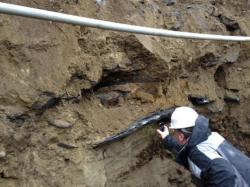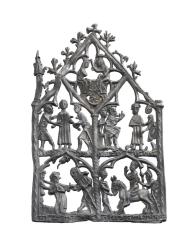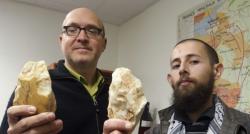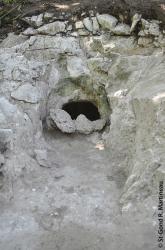INSTITUT SUPERIEUR D'ANTHROPOLOGIE
INSTITUTE OF ANTHROPOLOGY
ONLINE COURSES / COURS A DISTANCE
SPRING TERM : APRIL 2015
REGISTER NOW
BOLIVIE –  Tihuanaco - The government of Bolivia announced it will start exploratory excavations this year at the ancient fortress of Tiahuanaco after a buried pyramid was detected. Ludwing Cayo, director of the Tiahuanaco Archeological Research Center, told Efe that the formation is located in the area of Kantatallita, east of the Akapana pyramid. In a presentation for the media, Cayo outlined a five-year for further research at Tiahuanaco, an archaeological site 71 kilometers (44 miles) west of La Paz that was the cradle of an ancient civilization predating the Incas. Excavations may start in May or June, depending on the timing of cooperation agreements with foreign universities and institutes to enroll more forensic archaeology experts in the effort, Cayo said. Besides the pyramid, ground-penetrating radar has detected “a number of underground anomalies” that might be monoliths, but those findings require more detailed analysis. Tiahuanaco was the capital of a pre-Columbian empire known as Tiwanaku that left a legacy of impressive stone monuments such as Kalasasaya, the semi-underground Templete, sculptures of prominent figures, the Gate of the Sun and ruins of palaces. Bolivian researchers say Tiahuanaco began as an agricultural village around 1580 B.C. and grew to become an imperial state by A.D. 724, but was in decline by the late 12th century. At its peak, the Tiwanaku realm occupied over 600,000 square kilometers (231,000 square miles).
Tihuanaco - The government of Bolivia announced it will start exploratory excavations this year at the ancient fortress of Tiahuanaco after a buried pyramid was detected. Ludwing Cayo, director of the Tiahuanaco Archeological Research Center, told Efe that the formation is located in the area of Kantatallita, east of the Akapana pyramid. In a presentation for the media, Cayo outlined a five-year for further research at Tiahuanaco, an archaeological site 71 kilometers (44 miles) west of La Paz that was the cradle of an ancient civilization predating the Incas. Excavations may start in May or June, depending on the timing of cooperation agreements with foreign universities and institutes to enroll more forensic archaeology experts in the effort, Cayo said. Besides the pyramid, ground-penetrating radar has detected “a number of underground anomalies” that might be monoliths, but those findings require more detailed analysis. Tiahuanaco was the capital of a pre-Columbian empire known as Tiwanaku that left a legacy of impressive stone monuments such as Kalasasaya, the semi-underground Templete, sculptures of prominent figures, the Gate of the Sun and ruins of palaces. Bolivian researchers say Tiahuanaco began as an agricultural village around 1580 B.C. and grew to become an imperial state by A.D. 724, but was in decline by the late 12th century. At its peak, the Tiwanaku realm occupied over 600,000 square kilometers (231,000 square miles).
http://news.co.cr/archeologists-detect-ancient-pyramid-buried-in-bolivia/37872/
USA -  St. Johnsbury - Vermont archeologists are expecting to dig up and move nine graves during a foundation repair project at the Caledonia County courthouse in St. Johnsbury. The courthouse was built on top of an old cemetery in the 1850s and — at the time — many of the graves were moved. "Those that moved it apparently didn't do a very thorough job, based on the archaeology," John Crock, director of the University of Vermont's Consulting Archaeology Program, told the Burlington Free Press. "Some of the rows of graves in the original cemetery coincide with the building footprint, so there are actually individual grave shafts that run right up to the edge of the building," he said. The Burlington Free Press reports the original cemetery was used from 1790 to 1853.
St. Johnsbury - Vermont archeologists are expecting to dig up and move nine graves during a foundation repair project at the Caledonia County courthouse in St. Johnsbury. The courthouse was built on top of an old cemetery in the 1850s and — at the time — many of the graves were moved. "Those that moved it apparently didn't do a very thorough job, based on the archaeology," John Crock, director of the University of Vermont's Consulting Archaeology Program, told the Burlington Free Press. "Some of the rows of graves in the original cemetery coincide with the building footprint, so there are actually individual grave shafts that run right up to the edge of the building," he said. The Burlington Free Press reports the original cemetery was used from 1790 to 1853.
http://www.chron.com/news/article/Vermont-courthouse-renovation-expected-to-find-6166170.php
ROYAUME UNI –  Londres - Archaeologists digging in the banks of the Thames uncovered a rare 14th century devotional panel depicting the life and execution of a medieval politician-turned-rebel, which is going on display for the first time. A splendid example of propaganda and religious art, the panel is one of the largest and finest examples of its kind. It tells the tale of Thomas, Earl of Lancaster, a cousin of King Edward II and one of a group of barons who tried to curb the king’s power. Having caused huge political unrest, in 1322 Lancaster was defeated by Edward and publicly beheaded for treason near Pontefract Castle. Within six weeks of his death, miracles were being recorded in connection with his tomb. Although in life Lancaster had not been a saintly man, a cult soon built up around him, largely owing to the king’s unpopularity. The panel would have been made shortly after his death and is likely to have been associated with a shrine at St Paul’s Cathedral where an effigy of Lancaster had become a place of veneration. Uncovered by MOLA (Museum of London Archaeology) during excavations for Riverbank House on the north bank of the Thames, near London Bridge, in 2000, the metal panel has never been seen in public before, and will be on show at the Museum of London until 28 September.
Londres - Archaeologists digging in the banks of the Thames uncovered a rare 14th century devotional panel depicting the life and execution of a medieval politician-turned-rebel, which is going on display for the first time. A splendid example of propaganda and religious art, the panel is one of the largest and finest examples of its kind. It tells the tale of Thomas, Earl of Lancaster, a cousin of King Edward II and one of a group of barons who tried to curb the king’s power. Having caused huge political unrest, in 1322 Lancaster was defeated by Edward and publicly beheaded for treason near Pontefract Castle. Within six weeks of his death, miracles were being recorded in connection with his tomb. Although in life Lancaster had not been a saintly man, a cult soon built up around him, largely owing to the king’s unpopularity. The panel would have been made shortly after his death and is likely to have been associated with a shrine at St Paul’s Cathedral where an effigy of Lancaster had become a place of veneration. Uncovered by MOLA (Museum of London Archaeology) during excavations for Riverbank House on the north bank of the Thames, near London Bridge, in 2000, the metal panel has never been seen in public before, and will be on show at the Museum of London until 28 September.
http://londonist.com/2015/03/rare-medieval-propaganda-uncovered-in-thames-goes-on-display.php?
EGYPTE - Grand Egyptian Museum Director Tareq Sayyed denied news about a fracture in King Tutankhamun’s throne chair, saying that the items belonging to Tutankhamun's exhibit, which includes 1,700 pieces, will be transferred to the new museum by the end of December 2017, a few months before it opens. A photo that was published and purported to be Tutankhamun's throne, which resulted in rumors about the chair, was in fact a small table that was discovered in the Dahshur area in Egypt. It does not belong to any of the royal belongings and is being restored.
http://www.egyptindependent.com//news/grand-museum-chief-king-tutankhamun-s-throne-chair-not-broken
EGYPTE –  Abydos - The Antiquities Ministry is aiming to protect the Abydos Temple from collapse due to rising groundwater. The project will work on preserving the heart of the temple and the cemetery of Osiris by diverting the groundwater into vertical wells and linking them to water channels in order to get rid of the water, said director general of Luxor antiquities Sultan Eid on Sunday. Cleaning the temple and restoring the inscriptions, drawings and colors inside the temple will also be part of the project, Eid added. Abydos is one of the most important archaeological sites in both Egypt and the world due to its religious and historical significance in ancient Egypt. It contains the tombs of some of the early kings of Egypt during the reign of the first and second dynasty, as well as artifacts belonging to the 19th dynasty. It is the only temple which retains its ceiling, based on 36 pillars of granite. It contains the list of famous kings of Egypt, from King Menes until King Seti the First.
Abydos - The Antiquities Ministry is aiming to protect the Abydos Temple from collapse due to rising groundwater. The project will work on preserving the heart of the temple and the cemetery of Osiris by diverting the groundwater into vertical wells and linking them to water channels in order to get rid of the water, said director general of Luxor antiquities Sultan Eid on Sunday. Cleaning the temple and restoring the inscriptions, drawings and colors inside the temple will also be part of the project, Eid added. Abydos is one of the most important archaeological sites in both Egypt and the world due to its religious and historical significance in ancient Egypt. It contains the tombs of some of the early kings of Egypt during the reign of the first and second dynasty, as well as artifacts belonging to the 19th dynasty. It is the only temple which retains its ceiling, based on 36 pillars of granite. It contains the list of famous kings of Egypt, from King Menes until King Seti the First.
http://www.egyptindependent.com//news/antiquities-ministry-protect-abydos-temple-groundwater
FRANCE –  Milhars - Ce gros galet de 16 cm de long a le bout taillé en biseau, comme un hachoir. L'objet préhistorique gisait à Milhars, dans un champ, sur une terrasse au dessus de la rivière Aveyron. «Ce biface a été retrouvé il y a un mois ainsi qu'un autre, exhumé dans le même coin du Pays cordais. Ce sont les plus anciennes traces d'activités humaines décelées dans le Tarn», annonce Christophe Mendygral, président du Centre archéologique des Pays albigeois (Capa). «Cet outil fait dans du quartz aurait 300 000 ans, période qui correspond à l'Acheuléen finissant ou au début du Moustérien. C'est la taille considérable du biface et la manière dont il est façonné qui permet d'évaluer cette ancienneté record «à quelques dizaines de milliers d'années près. Équivalent du couteau suisse de l'époque, ces bifaces servaient à couper, à broyer des os, à gratter des peaux... La pointe était usée et c'est peut-être pourquoi on l'a jeté, comme on le ferait aujourd'hui avec un outil hors d'usage! On le prend très bien en main. C'est vraiment un outil manuel. Ces bifaces sont façonnés avec un tour de main très difficile à reproduire, par enlèvement d'éclats successifs», observe le président. Notre lointain ancêtre à qui on doit ces bifaces n'est pas un homo sapiens. «Plus vieux encore, c'était un homo erectus, plus petit et plus courbé que nous. C'était des nomades, qui venaient en Midi-Pyrénées et qui se repliaient en zone plus tempérée quand il faisait trop froid, suivant le gibier, car il y a eu trois périodes glaciaires durant l'Acheuléen. Le climat, mais aussi le paysage, plus plat, n'étaient pas ceux de maintenant. Les gorges de l'Aveyron n'étaient pas encore creusées autant. C'était même avant les mammouths, précédés par des mastodontes», dit encore Christophe Mendygral. «On ignore même si l'homo erectus parlait. Néanmoins, comme le montre la symétrie de ces bifaces, la sculpture témoigne d'un souci d'esthétique. C'est la naissance de l'art.»
Milhars - Ce gros galet de 16 cm de long a le bout taillé en biseau, comme un hachoir. L'objet préhistorique gisait à Milhars, dans un champ, sur une terrasse au dessus de la rivière Aveyron. «Ce biface a été retrouvé il y a un mois ainsi qu'un autre, exhumé dans le même coin du Pays cordais. Ce sont les plus anciennes traces d'activités humaines décelées dans le Tarn», annonce Christophe Mendygral, président du Centre archéologique des Pays albigeois (Capa). «Cet outil fait dans du quartz aurait 300 000 ans, période qui correspond à l'Acheuléen finissant ou au début du Moustérien. C'est la taille considérable du biface et la manière dont il est façonné qui permet d'évaluer cette ancienneté record «à quelques dizaines de milliers d'années près. Équivalent du couteau suisse de l'époque, ces bifaces servaient à couper, à broyer des os, à gratter des peaux... La pointe était usée et c'est peut-être pourquoi on l'a jeté, comme on le ferait aujourd'hui avec un outil hors d'usage! On le prend très bien en main. C'est vraiment un outil manuel. Ces bifaces sont façonnés avec un tour de main très difficile à reproduire, par enlèvement d'éclats successifs», observe le président. Notre lointain ancêtre à qui on doit ces bifaces n'est pas un homo sapiens. «Plus vieux encore, c'était un homo erectus, plus petit et plus courbé que nous. C'était des nomades, qui venaient en Midi-Pyrénées et qui se repliaient en zone plus tempérée quand il faisait trop froid, suivant le gibier, car il y a eu trois périodes glaciaires durant l'Acheuléen. Le climat, mais aussi le paysage, plus plat, n'étaient pas ceux de maintenant. Les gorges de l'Aveyron n'étaient pas encore creusées autant. C'était même avant les mammouths, précédés par des mastodontes», dit encore Christophe Mendygral. «On ignore même si l'homo erectus parlait. Néanmoins, comme le montre la symétrie de ces bifaces, la sculpture témoigne d'un souci d'esthétique. C'est la naissance de l'art.»
http://www.ladepeche.fr/article/2015/03/28/2076211-ces-bifaces-decouverts-a-milhars-ont-300-000-ans.html
FRANCE–  Tours - Des fouilles archéologiques sont actuellement en cours rue du Petit-Cupidon, à côté de l'ancienne clinique Saint-Augustin à Tours. Les archéologues ont découvert une ancienne petite nécropole avec 10 squelettes, d'adultes et d'enfants. Ils sont bien conservés. Il semblerait qu'ils aient été enfouis dans des linceuls. Ces ossements seront étudiés pour mieux connaître l'état sanitaire de ces lointains Tourangeaux. Ces squelettes dateraient du VIII ème siècle. L'autre intérêt du site archéologique porte sur les recherches menées en dehors de l'ancien rempart gallo-romain, au niveau de la fosse. Là, les archéologues de l'INRAP ont trouvé des vestiges d'habitat mérovingien, avec des tessons.
Tours - Des fouilles archéologiques sont actuellement en cours rue du Petit-Cupidon, à côté de l'ancienne clinique Saint-Augustin à Tours. Les archéologues ont découvert une ancienne petite nécropole avec 10 squelettes, d'adultes et d'enfants. Ils sont bien conservés. Il semblerait qu'ils aient été enfouis dans des linceuls. Ces ossements seront étudiés pour mieux connaître l'état sanitaire de ces lointains Tourangeaux. Ces squelettes dateraient du VIII ème siècle. L'autre intérêt du site archéologique porte sur les recherches menées en dehors de l'ancien rempart gallo-romain, au niveau de la fosse. Là, les archéologues de l'INRAP ont trouvé des vestiges d'habitat mérovingien, avec des tessons.
http://www.lanouvellerepublique.fr/Indre-et-Loire/Loisirs/Patrimoine-tourisme/n/Contenus/Articles/2015/03/25/Tours-les-archeologues-decouvrent-une-necropole-2271035
FRANCE –  - Saint-Gond - Vert-Toulon - Projet Néolithique 2014. VIDEO = https://www.youtube.com/watch?v=BOxhZ9ZhJ3E
- Saint-Gond - Vert-Toulon - Projet Néolithique 2014. VIDEO = https://www.youtube.com/watch?v=BOxhZ9ZhJ3E
USA –  Red Bank Battlefield Park - Researchers are digging into the New Jersey site of a major Revolutionary War battle. Officials are planning at archaeological dig for June at the site now known as Red Bank Battlefield Park in the southern New Jersey town of National Park. In 1777, Hessian soldiers hiked 10 miles to the site planning to surprise Colony forces. But they were trapped instead. Battlefield curator Jennifer Janofsky tells The Philadelphia Inquirer that belt buckles, cannonballs and other artifacts expected to be found could show where the fight was fierce. There are also hopes to find the exact site of the original fort there.
Red Bank Battlefield Park - Researchers are digging into the New Jersey site of a major Revolutionary War battle. Officials are planning at archaeological dig for June at the site now known as Red Bank Battlefield Park in the southern New Jersey town of National Park. In 1777, Hessian soldiers hiked 10 miles to the site planning to surprise Colony forces. But they were trapped instead. Battlefield curator Jennifer Janofsky tells The Philadelphia Inquirer that belt buckles, cannonballs and other artifacts expected to be found could show where the fight was fierce. There are also hopes to find the exact site of the original fort there.
http://www.nbcphiladelphia.com/news/local/NJ-Archeological-Dig-Battle-Site-Revolutionary-War-297988241.html?